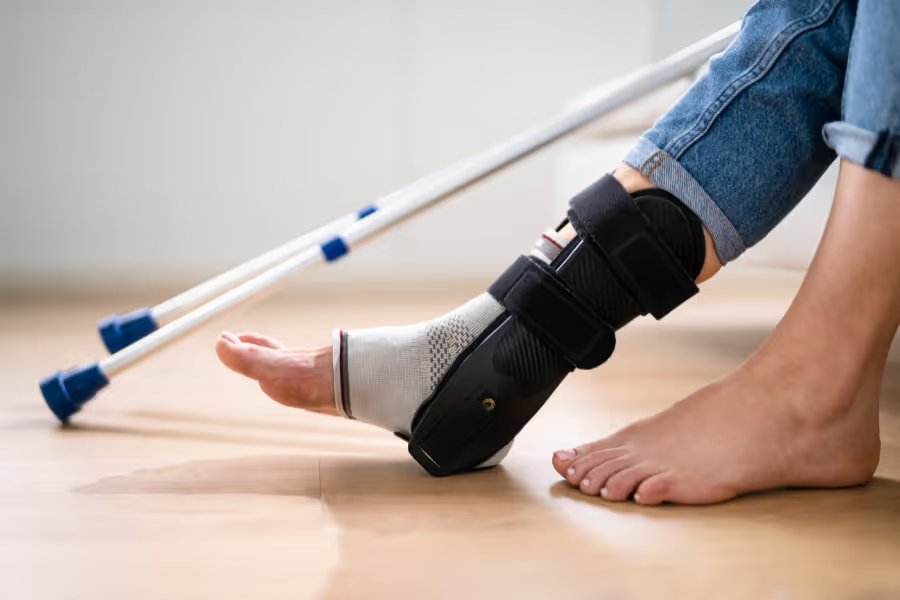Ankle replacement surgery may help if persistent ankle pain, stiffness, grinding, or swelling is disrupting your sleep, sports, work, and daily activities. Learn more and find the right surgeon that fits your needs below, serving Canadians in major cities like Vancouver, British Columbia; Calgary, Alberta; Toronto, Ontario; and Montréal, Québec.
Informational purposes only, not medical or legal advice. Please consult your doctor or surgeon.

Ankle replacement surgery (total ankle arthroplasty) is a procedure where a damaged ankle joint is resurfaced and replaced with artificial parts so the joint can move smoothly again. Your ankle is a hinge where the shinbone (tibia) meets the top of the foot bone (talus).
When arthritis or injury destroys the cartilage—the slippery tissue that lets bones glide—the joint becomes painful and stiff.In an ankle replacement, the surgeon removes the worn-out cartilage and a thin layer of bone from the tibia and talus. They then fit specially designed metal components onto those bones, with a tough plastic spacer between them. The metal acts like new joint surfaces, and the plastic works as the “glide” layer, letting the ankle bend up and down more naturally. The parts are aligned using guides and X-ray imaging so the new joint matches your leg’s mechanics and foot position.
Unlike a fusion (which permanently joins bones), a replacement aims to keep motion, helping with walking on uneven ground and everyday activities. It’s used mainly for severe ankle arthritis when non-surgical treatments haven’t helped and maintaining joint movement is a priority.
Time matters when every step hurts. Instead of waiting months (or longer) for consultation and OR time, private centres can often schedule surgery within weeks—reducing time spent with severe ankle pain and helping you return to daily life sooner.
Going private gives you more say in your care. You can:
Patients value knowing exactly who will operate, when it will happen, and the detailed plan (implant options, approach, rehab milestones). Clear timelines reduce anxiety and help patients coordinate time off, support, and physiotherapy.

Operating time: about 2–3 hours (can be shorter or longer depending on anatomy and complexity).Total visit: plan for most of the day with check‑in, anesthesia, and recovery.
Basic steps

Your plan comes from your surgical team and can vary. Take rehab seriously—the more consistent you are, the better your outcome. Some private clinics offer virtual follow-ups or coordinate physio near home.
In general, what to expect after ankle replacement surgery:
Week 1
Weeks 2–4
Weeks 5–12
Weeks 13–52
Red flags anytime
Ankle replacement is a major surgery. Private clinics in Canada typically charge $10,000 to $25,000.
In the United States, the average cost is between CA$20,100 and CA$55,200.
Costs vary so much because of location, surgeon experience, facility type, scope of potential treatments, complexity of the issue, and included services (some clinics offer all-inclusive, while others charge separately for anesthesia, followup care, etc.).
Choosing your surgeon is one of the benefits of going the private route. Here’s what to consider and the key questions to bring to your ankle replacement consultation.
Ankle replacement is a major surgery where the worn-out parts of your ankle joint are replaced with metal and plastic so it moves more smoothly and hurts less.
No, you do not need a referral for private ankle replacement in Canada. You can book a consultation directly with a surgeon, and they will review your condition, symptoms, and any previous treatments or diagnostics.
Your surgeon will tailor instructions to your case and implant choice.
Your own situation depends on your pain level, how far you can walk, what imaging shows (cartilage loss, bone spurs, deformity), your overall health, and how well non-surgical care works (bracing, shoes/orthotics, injections, meds, physio). Discuss specifics with your surgeon.
Your individual risk depends on your health, ankle anatomy and alignment, bone quality, surgical approach, implant type, and how closely you follow weight-bearing and rehab instructions. Discuss your specific risks with your surgeon.
If you still have questions, then feel free to contact us directly.

Browse vetted ankle surgeons across Canada. Compare prices, qualifications, locations.
BROWSE SURGEONS